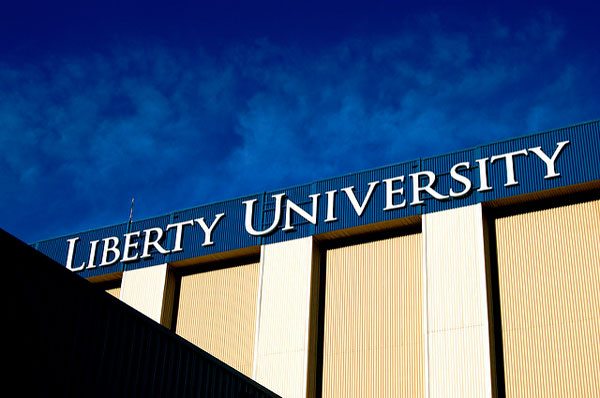
April 18, 2018; Vox
Jerry L. Falwell Jr.’s Liberty University in Lynchburg, Virginia generated $215 million in net income in 2016 on nearly $1 billion in revenue. This tax-exempt nonprofit university’s net assets now exceed $2.5 billion, up from $1.6 billion in 2016. Their recipe? “The booming and lightly regulated realm of online higher education,” mostly subsidized by student grants and loans from the US Department of Education and the US Department of Veterans Affairs.
In the past two years, NPQ has reported on this behemoth in Christian higher education—when some of its alumni protested Chancellor Falwell’s defense of President Trump’s remarks made after the Charlottesville white nationalist massacre; when Liberty hired Baylor University’s athletic director after he resigned in the midst of a “horrifying” sexual assault scandal at the Texas school; and finally, when Falwell strongly encouraged students and staff over 21 years of age to carry concealed weapons on campus.
This educational institution, with up to 95,000 students who learn remotely and 14,000 students who learn on campus, is second in the nation, trailing only the University of Phoenix, in providing online university education. The following are the key elements of its business model for generating huge revenues from its online line of business:
Sign up for our free newsletters
Subscribe to NPQ's newsletters to have our top stories delivered directly to your inbox.
By signing up, you agree to our privacy policy and terms of use, and to receive messages from NPQ and our partners.
- Government student aid. In 2017, Liberty students collectively received more than $772 million in aid from the US Department of Education, almost $100 million as Pell grants and the rest as federal student loans. This makes Liberty the nation’s sixth largest university recipient of federal aid. Also important to Liberty’s revenue stream are its enrolled veterans who secured $42 million in 2016 in grants and loans from the US Department of Veterans Affairs.
- Aggressive recruitment through its call center. Three hundred phone recruiters working out of a former Sears store in a nearby mall (majority-owned by the University) in Lynchburg are expected to sign up eight new students each day, using call lists secured from websites focused on higher education, e.g. BestCollegesOnline.com. Liberty paid Google $16.8 million for “admissions leads generation” according to its 2016 Form 990 tax filing. Another 60 recruiters focus on prospective students who are veterans or from military families.
- Low instructional costs. In 2016, the university reported spending $2,609 on instruction per full-time equivalent students across its traditional campus and online operations. The University of Phoenix, the nation’s biggest online provider of higher education, spends more than $4,000 per student in many states. And a hybrid online-traditional nonprofit religious college such as Ohio Christian University spent about $4,500 per student. Interestingly, Liberty’s 2,300 online instructors are not responsible for any teaching—they mostly handle email communications and give grades. The courses are mostly designed and updated by a Lynchburg-based team with a starting salary of $11/hour.
- Tax-exempt status. Liberty benefitted from the Obama administration’s second-term crackdown on for-profit online universities’ deceptive and fraudulent practices, which put at least two huge chains, Corinthian Colleges and ITT Technical Institute, out of business. As a nonprofit organization, Liberty was exempted from the new requirement that a certain percentage of graduates attain “gainful employment” and the earlier rule that for-profit institutions were limited from securing more than 90 percent of their revenue from federal sources. Liberty’s nonprofit status gave it a clear advantage over its for-profit competitors. That may change, however, as the Trump administration seeks to “correct” these Obama regulations and treat colleges the same, regardless of their IRS status.
- Lack of tenured faculty. On-campus traditional professors (except for the law school) do not have tenure and thus have only limited say in the university’s policy and practice. Chancellor Falwell credits this unusual academic practice for the university’s nimbleness. “The online program, I’m not sure that a university with tenure could implement something like that… Even our faculty was (initially) against it, because it’s new, it’s not traditional, it’s not what they’re used to. But eventually they embraced it.”
Liberty Online University invests its profits back into the Lynchburg campus, the heart of its mission to “train Champions for Christ with the values, knowledge, and skills essential for impacting tomorrow’s world.” Its $50 million library, $40 million football stadium upgrade, 275-foot-high Freedom Tower, and $3.2 million, 600-acre shooting range—not to mention the Snowflex Centre, “the country’s premier point for year-round skiing, snowboarding, and tubing”—are tangible evidence of the university’s robust finances.
Is there anything wrong with this aggressive pursuit of the online post-secondary market by a tax-exempt nonprofit that ploughs its profits back into its mission? Falwell’s annual salary of about $1 million is not unusual for executives of private colleges in the US. From the students’ perspective, we typically look at graduation rates, related job placements and post-program salaries as quantitative indicators of educational success. However, there is little, if any, publicly available data to peruse, only anecdotes. We really don’t know how successful—or not—Liberty University Online is in securing its undergraduate and graduate students their sought-after certificates and degrees.
In sum, given the large public dollars that are making it possible for the vast majority of Liberty’s on-campus and online students to attend this university, what questions should we as taxpayers be asking, and what data should be available to ascertain whether this online provider is providing a valuable service to its typical student—“36 years old, has some previous college experience, and wants an education with a touch of Christian values”? As online post-secondary education continues to become a major player, we consumers and taxpayers need some answers.—Deborah Warren













